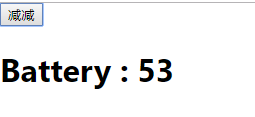React的contextType的使用方法简介
上一篇介绍了Context的使用方法。但是Context会让组件变得不纯粹,因为依赖了全局变量。所以这决定了Context一般不会大规模的使用。所以一般在一个组件中使用一个Context就好。
由于Consumer的特性,里面的代码必须是这个函数的返回值。这样就显得复杂与不优雅了。那该怎么解决呢?这样contextType就派上用场了。
还拿上一篇的demo来举例。并且修改它。 上一篇的代码:
import React, { Component, createContext } from 'react';
const BatteryContext = createContext();
//声明一个孙组件
class Leaf extends Component {
render() {
return (
<BatteryContext.Consumer>
{
battery => <h1>Battery : {battery}</h1>
}
</BatteryContext.Consumer>
)
}
}
//声明一个子组件
class Middle extends Component {
render() {
return <Leaf />
}
}
class App extends Component {
render(){
return (
<BatteryContext.Provider value={60}>
<Middle />
</BatteryContext.Provider>
);
}
}
export default App;
接下里我们修改他,使他更加优雅一些:
我们只需要修<Leaf/>组件的代码就可以。
首先我们用static来声明contextType:
static contextType = BatteryContext;
这样在运行时就可以获取到一个新的属性。我们来接收他。
const battery = this.context;
这样Consumer就可以完全不再使用了。
return<h1>Battery : {battery}</h1>
全部代码:
import React, { Component, createContext } from 'react';
const BatteryContext = createContext();
//声明一个孙组件
class Leaf extends Component {
static contextType = BatteryContext;
render() {
const battery = this.context;
return<h1>Battery : {battery}</h1>
}
}
//声明一个子组件
class Middle extends Component {
render() {
return <Leaf />
}
}
class App extends Component {
state = {
battery: 60,
}
render() {
const { battery } = this.state;
return (
<BatteryContext.Provider value={battery}>
<button
type="button"
onClick={() => this.setState({ battery: battery - 1 })}
>
减减
</button>
<Middle />
</BatteryContext.Provider>
);
}
}
export default App;
效果图:

效果和使用Consumer没有什么区别。可见只有一个Context的时候,使用contextType要比使用Consumer简单的多。


 浙公网安备 33010602011771号
浙公网安备 33010602011771号